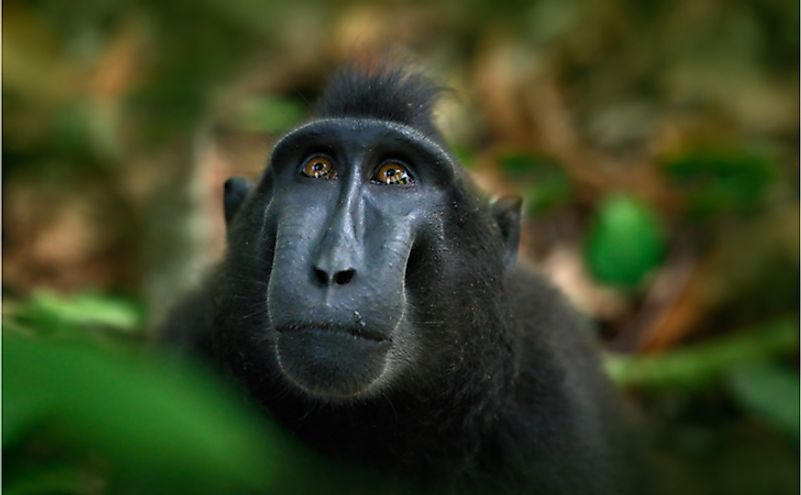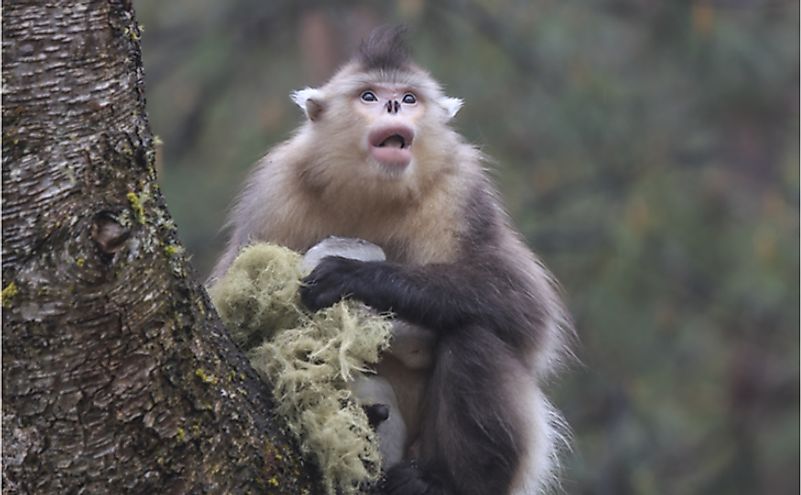The 15 Species Of Critically Endangered Old World Monkeys

Old World monkeys are a group of primates native to Old World regions of the world, which include Africa, Southeast Asia, and India. Several characteristics distinguish Old World monkeys from New World monkeys. Old World monkeys are relatively larger compared to New World monkeys. They have opposable thumbs (similar to apes) and have nails on all toes and fingers. They also have nostrils that point down and are closer together (more like humans), while the New World monkeys have nostrils that point to the side. There are about 133 species of Old World monkeys classified into two subgroups; the Colobinae and the Cercopithecinae. The Colobinae consists of Asian species (and a few African species) such as red colobuses, snub-nosed monkeys, langurs, and lutungs. On the other hand, the Cercopithecidae consists of African species such as baboons, macaques, mandrills, and mangabeys. Some of the Old World monkeys that are critically endangered include Dryas monkey, Pagai Island macaque, Celebes crested macaque, Miss Waldron’s red colobus, Preuss’s red colobus, kipunji, and the Sarawak surili.
Dryas Monkey
The Dryas monkey, which is also known as the Solanga monkey or ekele and scientifically known as Cercopithecus dryas is a species that is found in the Congo Basin. Its range is restricted to the left bank of the Congo River. They prefer areas with secondary forests but are also known to inhabit swampy lowlands and regions along the Congo River. Dryas monkeys feed on fruits, young leaves, and flowers. Occasionally, they also feed on invertebrates. It is considered a very rare species, with its total population numbering less than 200 individuals. Consequently, the species is listed as critically endangered on the IUCN Red List.
Celebes Crested Macaque
The Celebes crested macaque is scientifically known as Macaca nigra. Other common names for the species include Sulawesi crested macaque and crested black macaque. The species is found in the Tangkoko Reserve in the northeastern part of Sulawesi (Celebes) Island, Indonesia. The species prefers rainforest habitats. They spend over 60% of their day foraging for food on the ground, socializing, sleeping, and searching for food in the trees. Their diet consists mainly of fruits. The diet is also supplemented with leaves, seeds, buds, eggs, insects, fungus, and occasionally with lizards and frogs. Celebes crested macaque is considered critically endangered by the IUCN.
Pagai Island Macaque

The Pagai Island macaque, which is also known as the Bokkoi, is scientifically known as Macaca pagensis. The species is native to the Mentawai Islands to the west of Sumatra. Their natural habitat consists of rainforest. They can also be found in coastal swamp-forest and riverine areas. The species lives in forest canopies and forage at trees standing at heights of between 78 and 118 feet above the ground. Their diet consists of figs. The Pagai Island macaque is currently listed as critically endangered on the IUCN red list.
Niger Delta Red Colobus
The Niger Delta red colobus, also scientifically known as Piliocolobus epieni, is a species of the colobus monkey native to the western part of the Niger Delta. The species prefers living in marsh forests (forests that have a high water table throughout the year but do not experience significant flooding). The species relies on a diet comprised of leave buds and young leaves, which is supplemented with seeds and flowers in the upper canopy. Unlike other red colobus populations, the species spends most of its day traveling. Niger Delta red colobus monkeys are considered critically endangered by the IUCN. Some researchers have also termed it as one of the most elusive primates on the African continent.
Preuss’s Red Colobus
Preuss's red colobus is scientifically known as Piliocolobus preussi. It is found mainly in the Cross-Sanaga Rivers eco-region situated in southeastern Nigeria and southwestern Cameroon. A significant portion of the population exists in Korup National Park in Cameroon and Cross River National Park in Nigeria. There have also been sightings of the species in other forests, including Ebo and Nta Ali. They inhabit lowland and mid-altitude moist forests of up to 4,593 feet above sea level. Preuss’s red colobus monkeys are leaf eaters, often preferring young and immature leaves from several tree species. Preuss's red colobus is listed as critically endangered by the IUCN. The greatest threat to the population is hunting.
Miss Waldron’s Red Colobus
Miss Waldron’s red colobus is a species of red colobus monkey endemic to West Africa. The species is scientifically known as Piliocolobus waldronae. Miss Waldron’s red colobus monkey has not been officially spotted since 1978. The species was considered extinct in the year 2000. However, there is evidence suggesting that a small population of these monkeys exist in the southeastern part of Cote d’Ivoire. The species has a preference for high-canopy rainforests. The diet consists of fruit, seeds, and foliage. Miss Waldron’s red colobus is currently classified as critically endangered. The biggest threat to the species is poaching for bushmeat and habitat loss.
Sarawak Surili
The Sarawak surili is scientifically known as Presbytis chrysomelas. It is a primate species that belongs to the Cercopithecidae family. They are native to the island of Borneo, where they can be found in the Malaysian states of Sabah, Brunei, and Sarawak. The species is also found in Kalimantan, Indonesia. Sarawak surili monkeys live in swamps, mangroves, and lowland forests. Their diet consists of fruit, seeds, and leaves. According to IUCN, Sarawak surili monkeys are currently considered critically endangered.
Grey-shanked Douc

The grey-shanked douc is scientifically known as Pygathrix cinerea. They are endemic to Vietnam and can be found in the country’s central highlands, high in the forest canopy. Their home range includes the Vietnamese provinces of Kon Tum, Quang Nam, Gia Lai, and Quang Ngai. Grey-shanked douc monkeys are mainly herbivorous. Their diet consists of leaves, fruit, nuts, seeds, and flowers. There are currently about 550 to 700 individuals in existence. Habitat destruction and hunting are the main threats facing the population, which is on a downward trend. Consequently, the species is listed as critically endangered by the IUCN.
Tonkin Snub-nosed Monkey

The Tonkin snub-nosed monkey, scientifically known as Rhinopithecus avunculus was thought to have gone extinct before its rediscovery in 1989. The rare and elusive species is only found in northern Vietnam. The species inhabits subtropical areas with its range currently restricted to small areas within the provinces of Ha Giang, Bac Kan, Tuyen Quang, and Thai Nguyen. They live in primary forests with broad-leaved evergreen vegetation and bamboo. Such forests are typically found on hilltops and mountains formed from karst limestone. The species feed on leaves from bamboo and evergreen trees. They also feed on a variety of fruits, seeds, and flowers. Tonkin snub-nosed monkeys are currently considered critically endangered by the IUCN.
Myanmar Snub-nosed Monkey
The Myanmar snub-nosed monkey is scientifically known as Rhinopithecus strykeri. The monkey was discovered in 2010 and classified as a distinct species in 2011. The species is mainly found in Myanmar and China. In Myanmar, they inhabit mountain forests in the watershed of Lakin and Maw rivers while in China, ten groups of the species can be found on the eastern slopes of the Gaoligong mountain range. Their diet consists of fruit, buds, seeds, barks, and lichens. The species is considered critically endangered by the IUCN.
Kipunji
The kipunji, which is sometimes called the highland mangabey and scientifically known as Rungwecebus kipunji, is endemic to the highland forests of Tanzania. The species consists of two main populations one in the Rungwe-Kitilo forest and the other in the Ndundulu Forest Reserve. Kipunji monkeys prefer the safety of forests and avoid open spaces. They feed on leaves and fruits, and they are also known to consume seeds, bark, fungi, and moss. According to IUCN, the kipunji is currently listed as critically endangered.
Pig-tailed Langur
The pig-tailed langur, scientifically known as Simias concolor, is endemic to Indonesia. The species can be found on the archipelago of Mentawai to the west of Sumatra. The population is interspersed across the islands of Sipora, Siberut, South Pagai, and North Pagai. They inhabit primary forests, mangrove forests, lowland forests, and fresh-water, brackish-water swamp forests. The species feeds on fruits, young leaves, and flowers. Pig-tailed langur monkeys are considered critically endangered by the IUCN.
Delacour’s Langur

Delacour's Langur is sometimes called Delacour’s lutung. The species is scientifically known as Trachypithecus delacour and is native to northern Vietnam. They inhabit open subtropical rainforests and spend most of their time in limestone caves. Their diet consists of leaves, fruits, tree bark, and flowers. Delacour’s langur monkeys are listed as critically endangered by the IUCN.
Bouvier’s Red Colobus
The Bouvier’s red colobus is scientifically known as Piliocolobus bouvieri. The species was presumed extinct but was rediscovered in 2015 in the Republic of Congo. The monkey lives in swamp forest habitats. Sightings of the species have been made in the Ntokou-Pikounda Park in the Republic of Congo. Its diet consists of leaves and fruits. Bouvier’s red colobus monkeys are currently classified as critically endangered by the IUCN.
White-headed Langur
The white-headed langur is scientifically known as Trachypithecus poliocephalus. There are two subspecies of the monkey that are recognized; the T.p.poliocephalus, which is found in Cat Ba Island in Vietnam, and T.p.leucocephalus, which is found in Guangxi, China. The T.p.poliocephalus subspecies, also known as the Cat Ba Langur or golden-headed langur, is one of the rarest monkeys in Asia with a population of fewer than 70 individuals. The species prefers living in moist tropical forests where the topography is made of rugged limestone. Their diet consists of leaves, shoots, fruits, barks, and flowers. The species is considered critically endangered by the IUCN.
Conservation Of Old World Monkeys
Scientists think that immediate action is needed to save critically endangered Old World species. Some of the proposed steps include blocking off access routes to protected areas that are typically used by hunters. Fenced protected areas have also been suggested to keep the monkeys from people’s farms and consequently avoid unnecessary monkey deaths as a result of retaliation. Governments are also encouraged to foster the eco-tourism model, which is likely to help neighboring communities earn revenue from aiding in the protection of endangered species.











